Omission of the right kidney: symptoms, causes and effective treatments for the disease
Characterized by increased mobility of the body. A natural process is considered to be a slight displacement of the kidney within its bed, which is formed by fatty tissue and ligaments during breathing or movement. The descent of the kidney leads to its movement from the lumbar down. In some cases, the displacement of the organ into the pelvic cavity was diagnosed.
The disease develops under the influence of internal and external factors, which are the main causes of pathology. Omission of the right kidney cannot occur for one specific reason; most often, a number of provoking factors are required to weaken the ligaments that strengthen the position of the organ.
The causes of the pathological process include:
- rapid loss of large amounts of body weight (shrinkage of the renal capsule formed by adipose tissue)
- weakening of the muscular corset in the abdomen and lower back (occurs more often in older people)
- damage to tissues in the lumbar region, which are caused by trauma (falls, bruises, operations, etc.)
- (in most cases when carrying two or more fetuses)
- excessive physical activity (strength sports, constant weight lifting, etc.)
- anatomical underdevelopment of ligament tissues, as a result of which the entire ligamentous apparatus is weakened in the body
The greatest risk of developing the disease are people who are exposed to a long stay in a standing position or constant vibration (the specifics of the profession). With a professional predisposition to the omission of the kidney, regular diagnostics follow.
Symptoms of kidney prolapse
Kidney disease is not asymptomatic. The lower the body falls, the more intense the symptoms. However, at the initial stage, the signs of the disease do not appear immediately. Symptoms of the pathological process can also have an individual feature of manifestation, depending on the causes of the disorder and concomitant diseases.
Common symptoms of right kidney prolapse:
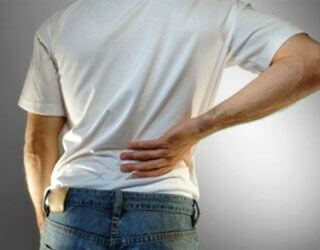
- nervous, pain and dyspeptic disorder
- sharp and blunt
- constant feeling of pain in the lower back
- feeling of enlargement of the organ in the right hypochondrium
Symptoms of the disease, expressed by pain, disappear after a slight rest in the supine position. Many patients confuse the symptoms of kidney disease with and are in no hurry to contact a medical facility. This leads to the development of subsequent stages of pathology, which cause more serious deviations in the functioning of the body.
Stages of symptoms
In the absence of therapeutic medical treatment, the patient begins to develop symptoms of greater intensity. Depending on the stage of nephroptosis, the clinical picture becomes more complicated. Gradually, the patient begins to suffer from constipation, stomach pain, nausea, vomiting and bloating.
Symptoms of the pathological process are divided into three stages:
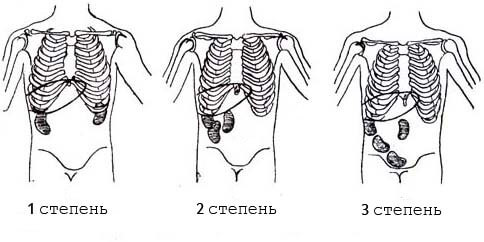
- At the initial stage of nephroptosis, a person feels slight pain in a standing position, which increase under the influence of physical exertion. After rest, the kidney can take its bed and the pain subsides.
- At the second stage, when the organ falls even lower, the pain becomes more pronounced, it can become permanent. At this stage, there is an inflection of the vessels of the kidney and ureter, which leads to a violation of the outflow of urinary fluid and blood supply. Many patients are diagnosed with ischemia, as well as renal venous hypertension. The pathology of renal and urinary hemodynamics is determined. There is blood in the urine.
- At the last third stage of the progression of the disease, the signs that have already arisen increase in intensity. Painful sensations in the third stage are strong and do not go away even after rest. Severe renal ischemia, edema and venous hypertension are detected. All these violations of the functionality of the body provoke an inflammatory process (pyelonephritis and cystitis), which are dangerous for human life.
When detected, blood, protein and leukocytes. Under the influence of nephroptosis, pressure (arterial) increases, which is influenced by renin (a hormone produced by the affected kidney).
Diagnosis of the disease
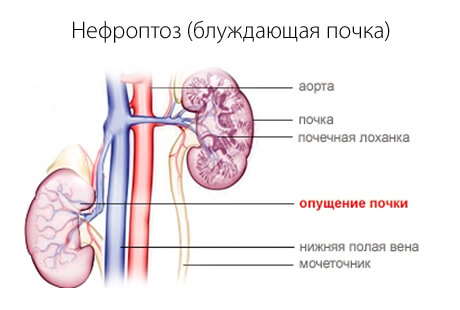
It is impossible to determine the prolapse of the right kidney without a detailed medical diagnosis, since many of the symptoms of the disease are similar to other diseases. After the occurrence (lower back pain), it is necessary to contact specialists who will prescribe an examination.
Diagnosis of nephroptosis is performed using laboratory and hardware studies. The diagnosis is made only after receiving all the results of the diagnosis and determining the exact clinical picture.
Laboratory studies are carried out by taking a blood and urine test to detect pyelonephritis or venous hypertension. To determine the mobility of the kidney is carried out:
- urography (with the introduction of a contrast agent)
An ultrasound and X-ray examination may also be prescribed. Hardware is performed more often in a standing position in order to track the descent of the kidney. If the distance between the organ and the bed is greater than the length of the vertebral body, then this condition is considered pathological.
An equally important step is the examination of the patient by a specialist. During the examination, the doctor palpates the person in an upright position to determine the position of the organ. Based on the survey, examination and the results of the diagnostics, the doctor makes a diagnosis and determines the treatment regimen.
Effects
The omission of the right kidney affects the functionality of the whole organism. First of all, the pathological process leads to a violation of the output of urine from the organ, which leads to insufficient blood supply. Despite the fact that in the early stages of the disease, symptoms may be absent or mild, comorbidities begin to develop gradually. During the time until the disease is diagnosed, the processes caused by hydronephrotic changes progress.
One of the most serious and common diseases that occurs against the background of nephroptosis is the cause of pyelonephritis is the stagnation of urine. As a result of the accumulation of urinary fluid in the organ, conditions are formed that are ideal for the onset and progression of infection.
Against the background of pyelonephritis, the patient has:

- fast fatiguability
- periods of fever
- persistent migraines
Many people suffering from nephroptosis, even after long-term treatment, may develop renal colic and inflammation of the perinephric tissue. Lack of treatment also leads to such consequences as the formation of adhesions between the fiber (fat), the renal capsule itself and nearby organs.
The consequences of nephroptosis also become:
- urolithiasis disease
- spontaneous miscarriages
- arterial hypertension
The lack of treatment or its ineffectiveness leads to the fact that the patient develops a chronic form of the pathology "fixed nephroptosis". This disease is characterized by fixing the kidney in a lowered position. With this form of pathology, therapeutic treatment is powerless, only surgical intervention can give a result.
Conservative therapy
The process of treating the prolapse of the right kidney can be carried out therapeutically and surgically, the method of treatment chosen by the doctor depends on the available indications. In the first stages of the progression of nephroptosis, the disease can be managed with conservative methods, and if there are risks of serious complications or with a fixed form, the specialist decides to perform the operation, since the disease cannot be eliminated by therapy.
The therapeutic effect should be carried out only in the absence of inflammatory or infectious processes. All necessary recommendations are given by the attending physician. Self-treatment is not recommended. Do not forget that the kidney is a vital organ.
Conservative therapy includes:
- wearing a bandage
- therapeutic gymnastics
All therapies are individual. The type of fixing device, the course of exercise therapy and dietary nutrition are determined by a specialist based on many indicators (indications, body characteristics, contraindications, etc.).
Wearing a bandage
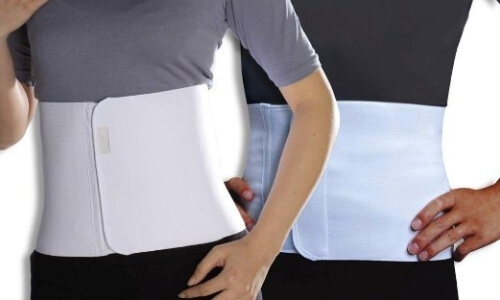
After the diagnosis is established, the patient is recommended to regularly wear an orthopedic device (bandage). The peculiarity of the use of a bandage in this form of renal pathology is that the device is put on before getting up in the morning from the pastel, since it is necessary to fix the organ in the correct position. Before fixing the organ, you need to take a breath.
There are special exercise therapy courses that are designed to treat nephroptosis. However, the choice of gymnastic exercises should be done only by a specialist. It should be borne in mind that a change in body position affects the displacement of the kidney.
- restrictions on the possible mobility of the organ
- recovery of intra-abdominal
- strengthening the muscular corset, affecting the fixation of the organ
Exercise therapy should not be performed if the patient:

- there are concomitant pathologies of the kidneys
- impaired excretory function
- there is a period of exacerbation
- pain is present
It is desirable to track all these daily, despite doing gymnastics at home. Exercise should be done twice a day. With the consent of the doctor, the removal of the bandage is allowed.
Diet
Significantly affects the functioning of the kidneys. However, a diet for nephroptosis is not just proper nutrition, but a diet specially designed for the patient, excluding foods that affect the functionality of the organ and systems associated with it.
Most often, the diet is recommended for people who have a disease as a result of targeted rapid weight loss or weight loss due to another disease. The diet for renal pathology is high-calorie, it includes the use of foods that are saturated with fats and carbohydrates.
The purpose of special nutrition is to restore the affected renal capsule and tissues adjacent to it. You should eat foods that do not lead to the formation of toxins. The exact list of recommended products is determined by the attending specialist, who has information about all the features of the patient's body.
Surgery
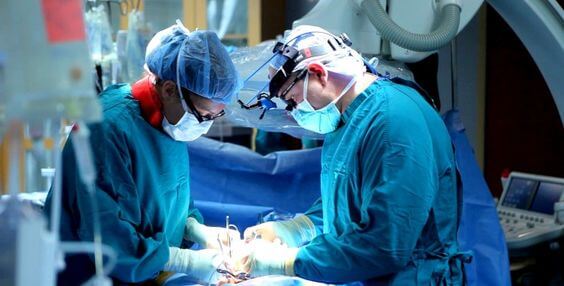
In the absence of results from the therapeutic treatment, or in the case of diagnosing the prolapse of the right kidney in the later stages, therapeutic measures include surgical intervention.
An operation is performed to fix the body in its natural position. Surgical intervention can only be carried out by a specialist with the qualification "surgeon - urologist". As a result of the operation, the organ is fixed in its anatomical position. However, experts do not guarantee a relapse after some time. If the pathology is provoked by another disease, then the prolapse of the kidney may not resume, but if the violation is caused by the anatomical features of the patient, the situation may repeat itself.
Modern medicine uses laparoscopy to perform the operation. is carried out by performing several small punctures in the abdomen, through which a camera and special instruments are inserted.
Unlike traditional methods, this method of surgical intervention has certain advantages:
- the recovery period is faster and much easier
- the presence of minimal risks
- minor blood loss
- less traumatic
Self-treatment for nephroptosis of the right kidney is unacceptable. aimed at restoring the position of the body cannot be effective, since no herbs, ointments and other means can affect physical changes in the body. Treatment should be carried out exclusively in accordance with the instructions of a specialist.
ethnoscience
At home, folk remedies can only be used to alleviate the patient's condition. It is permissible to reduce the intensity of signs of nephroptosis by folk methods only after consulting a doctor.

- Flax seeds (sunflower or pumpkin). The seeds are fried in a pan, without adding oil. Then use a tablespoon twice a day. You need to eat seeds on an empty stomach or at least before a meal. Pumpkin or sunflower seeds are consumed after cleaning.
- Crown cochia. Made from a plant. The stem of the plant is poured with boiling water in a ratio of 1: 3. Then the container with the infusion is wrapped and left for half a day. After the liquid is infused, it is filtered and drunk three times a day, 1 tbsp. l. between meals.
Omission of the right kidney is a disease that requires long-term complex treatment. It is impossible to get rid of it only with a diet or a folk remedy. Only a professional and the implementation of all the recommendations given by the doctor involved in the treatment can help.
Noticed an error? Select it and click Ctrl+Enter to let us know.
Aug 16, 2016 Violetta Doctor




